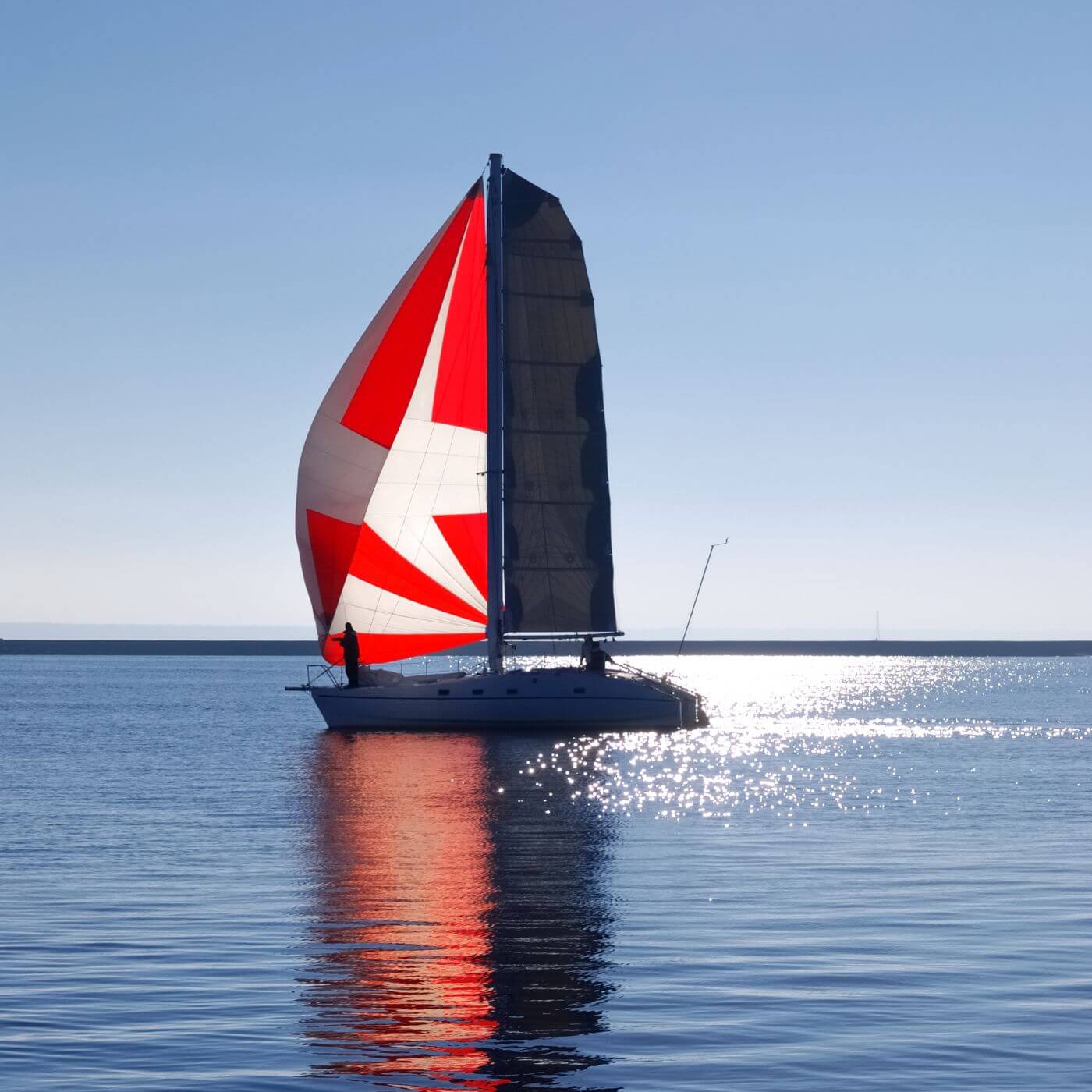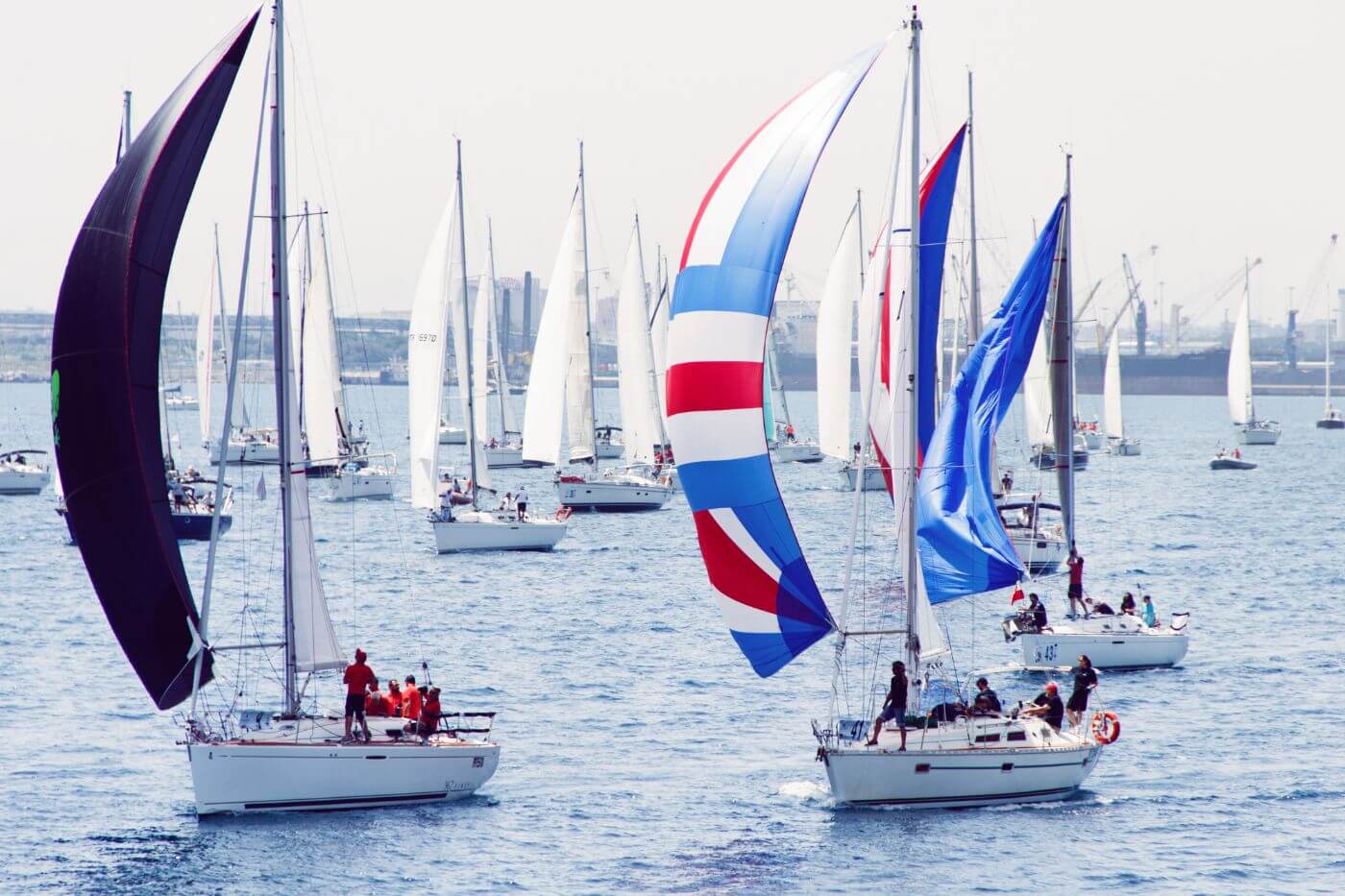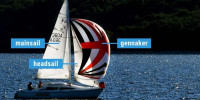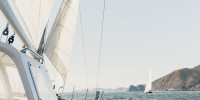Spinnaker vs. Gennaker: the Difference Explained
There are few sailing images more iconic than a fleet of race boats on the horizon with colorful sails ballooning out as they round a mark and start heading down wind. "Look at that spinnaker!" you say, then a moment later the salty guy next to you says, "that's not a spinnaker, it's a gennaker."
What?
What is the difference between a spinnaker and a gennaker? A conventional, or symmetrical spinnaker is made from light nylon cloth and is symmetrical, with identical tapes on each side and no distinct luff or leech and is used to sail deep angles downwind. A gennaker has similar light construction, but with a distinct leech and luff of different lengths, and is used for sailing on broad reaches and further upwind.
The name "gennaker" comes from the sail being a spinnaker-like sail which trims more like a Genoa, an oversized upwind sail. Confused? Don't be - the definitions are a little fuzzy, but we can clear them up for you.

On this page:
Downwind Sailing Physics
Any boat can sail downwind with just the basic white sails - a main and a job. But when you head downwind, the sails become less efficient, from their shape and their weight. Upwind sails work like airplane wings and are trimmed to give lift. But downwind, the air is behind them, and they drive the boat by filling and pulling it.
When you get far downwind, this is slow, and a lot less fun as it’s tough to keep a heavy sail full as the boat rocks and rolls and the wind shifts. The breeze is lighter, and the heavier laminate or cloth sails used to sail upwind are hard to trim for it. You can offset some of this with whisker poles, but jib and main sailing off the wind is something racers avoid if they have a spinnaker.
Apparent vs. True Wind
In fifteen knots of true wind, a boat sailing upwind might feel like it’s in over twenty knots of breeze. But sailing downwind, that same fifteen knots of wind may feel like ten knots or less. A breezy, bouncy upwind sail with a lot of heeling and spray can turn into a slow, hot and frustrating sail the moment you turn downwind.
The reason is apparent wind. Imagine riding a bike at ten miles per hour - on a still day, an anemometer on the bike will read ten miles per hour. Now, picture riding that bike with a ten mile per hour headwind; the anemometer will read twenty miles per hour. But if you are riding with a ten miler per hour breeze behind you, it will feel you are in no wind at all!
This is apparent wind - how the true wind feels to the boat when the boat is sailing, and it is wind the boat sails in. When you sail upwind, it feels like there is more wind, but downwind in the exact same breeze feels much lighter. The deeper you sail downwind, the lighter the apparent wind. But a gennaker can help you take advantage of the higher apparent wind you get sailing hotter reaching angles.

Sail Trim, Blanketing, and Goose Wings
Sailing upwind, we trim the sails like wings for lift. But downwind they need a lot of curve to catch the lighter apparent wind from behind. In a heavy sail, this is difficult to shape and keep shape, as the shape of the sail only holds when it fills with wind. There are tricks to help this, like moving the genoa cars far forward and barber-hauling the sail. But even then, once you get far enough downwind, an upwind headsail gets blanketed by the main and will collapse.
Barber-hauling is running a sheet to the headsail outside the boat to give a better shape to an upwind sail on a deep, broad reach. A second sheet is run through a snatch block midships and outside the boat to control the clew.
One way to avoid sail collapse is to sail wing-on-wing or goose-winged. Tack the headsail around to the opposite side of the boat from the main, so there is one sail on each side of the boat. A whisker pole or spinnaker pole on the windward sheet will stave off sail collapses. This is faster at deep angles of sail, but you must sail very deep and watch out for accidental gybes, especially if sailing by the lee.
“Sailing by the lee” is sailing downwind slightly past dead downwind without gybing the main. It’s tricky because you don’t want an accidental gybe. But it’s often the best angle for wing-on-wing speed, but you may want a preventer.
It works, but it’s nothing like a spinnaker off the wind.

Offsetting it with Spinnakers
To deal with the problems of sailing off the wind, we developed the spinnaker. Made from much lighter nylon cloth, conventional spinnakers fill well in the light apparent winds sailing on a run. Spinnakers have evolved to several specialized applications - the symmetrical and asymmetrical spinnakers (also referred to as “kites” or “chutes”, regardless of cut).
Deep Downwind - the Symmetrical Spinnaker
The symmetrical spinnaker came first and is more complicated and challenging to set and sail. We’ve got a basic guide for it here, so I won’t go into more detail. It involves many control lines for both the sail and the spinnaker pole, though the number varies by boat and wind conditions. Gybing and setting is more complex. The sail attaches to the boat only by a halyard at the head and the control lines.
Because a pole is used to project the sail to the windward side, the symmetrical spinnaker can sail deeper angles and carry to dead downwind, and even sail by the lee. Though this may not be the fastest point for your boat, so experiment with what works.
Boats set up for symmetrical spinnakers can fly asymmetrical chutes, but class and racing rules may prohibit or penalize the boat for it.
Less Downwind - the Asymmetrical Spinnaker
An asymmetrical spinnaker (like a gennaker) has a distinct leech and luff, and it has a tack and clew. They attach at the head with a halyard, and the tack connects at deck level, usually to a sprit or other attachment point with an adjustable tack line.
With no pole, the only sail control needed is the sheet. Setting the sail is simpler, as is gybing it. But without a pole and attached at the tack, asymmetrical spinnakers can not carry downwind like their symmetrical cousins. We sail them at higher reaching angles, from a broad reach to a close reach.
These reaching angles generate a lot of boat speed, and large sails move a boat at speeds fast enough to offset the lack of downwind sailing angles. When your next waypoint is straight downwind, instead of getting there by sailing as straight at it as possible, you sail higher, hotter, and faster angles with a giant asymmetrical spinnaker.
This is pretty fun, by the way.
A lot of modern race boats have sprits and only carry asymmetrical spinnakers and do their downwind sailing at fast and even planing speeds. Small boats with sprits can carry huge kites.
Most asymmetrical sails are carried to a beam reach, and a gennaker can carry a little upwind to a close reach because they work like upwind sails when trimmed this way. They are very handy for light air sailing in beam and close reaching and can give a good speed boost on a light, sultry day.
The Gennaker
A gennaker is, technically, an asymmetrical spinnaker. The name is fuzzy, like how a Genoa is a headsail over 100% of the foretriangle size, but the specifics of what makes it a “gennaker” versus other asymmetrical spinnakers is less clear. Cut flatter with less camber than a spinnaker, they are designed for higher angles of sailing.
Socks, Turtles, Furlers and Launchers
I cannot understate the ease of handling asymmetrical spinnakers and gennakers compared to a symmetrical kite with a pole. Advances in deployment technologies such as spinnaker socks, furling spinnakers, and other tools to set and douse these sails have not only helped racers but brought decent off the wind sailing to the world of cruisers and more casual sailors.
A sock is, as the name implies, a long, lightweight tube of nylon that goes over a gennaker. It may have a turtle - a hard plastic hoop or collar - to gather the sail back into the sock. When we hoist a socked spinnaker, it looks like a large, fat worm being dragged up by the halyard. To set it, pull a line on the turtle that raises it to the masthead, which pulls back the sock and lets the sail open and fill.
Dousing is easy too - ease or blanket the sail and haul the turtle down. It gathers the sail back up and pulls the sock over it, then you lower the sock full of sail to the deck and bag it.
Materials advances with high modulus lines have led to lightweight, removable gennaker furlers. They hoist on a halyard furled, then can be furled and unfurled like any regular sail. With these sail handling tools, the cruising gennaker has become a staple of the modern offshore cruising sail inventory.
Did you find the answer to your specific question?
👍 19 👎 9


Leave a comment